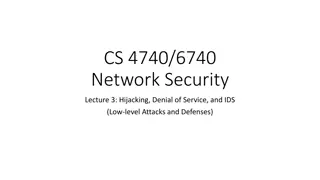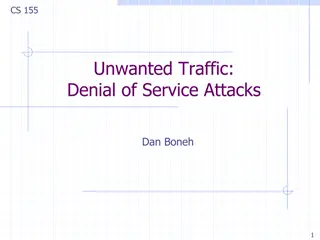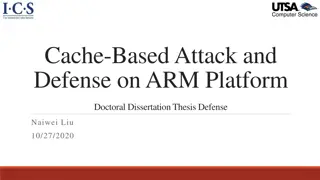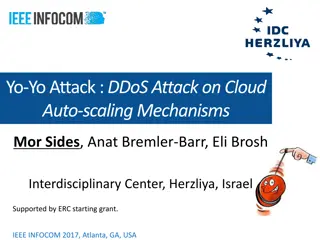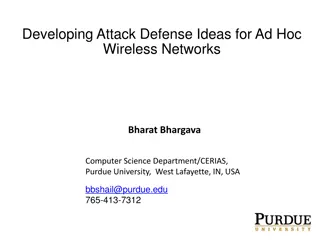Understanding Denial-of-Service Attacks and Defense Strategies
Denial-of-Service attacks pose a serious threat where attackers flood networks with traffic, leading to system crashes and slowdowns. Explore the impact, expected results, and various categories of DoS attacks such as bandwidth attacks, protocol exceptions, and logic attacks. Learn how to defend against these malicious activities and safeguard your systems from potential disruptions.
Download Presentation

Please find below an Image/Link to download the presentation.
The content on the website is provided AS IS for your information and personal use only. It may not be sold, licensed, or shared on other websites without obtaining consent from the author. Download presentation by click this link. If you encounter any issues during the download, it is possible that the publisher has removed the file from their server.
E N D
Presentation Transcript
Contents Denial of Service attacks Concepts Samples of attacks Malicious Logic attacks Concepts Viruses 3 Nov 27, 2007
Denial of Service Attack Attack in which the primary goal is to deny the victim(s) access to a particular resource. Possible impacts: reboot your computer, Slows down computers- Certain sites, Applications become inaccessible
Results expected Denial-of-service attacks can essentially disable your computer or your network. Depending on the nature of your enterprise.
Results expected Some denial-of-service attacks can be executed with limited resources against a large, sophisticated site. This type of attack is sometimes called an "asymmetric attack . For example, an attacker with an old PC and a slow modem may be able to disable much faster and more sophisticated machines or networks.
How to take down a restaurant? Table for four at 8 o clock. Name of Mr. Smith. Restaurateur O.K., Mr. Smith Saboteur Saboteur vs. Restaurateur
How to take down a restaurant? Restauranteur No More Tables! Saboteur
Categories of DoS attack Bandwidth attacks A bandwidth attack is the oldest and most common DoS attack. In this approach, the malicious hacker saturates a network with data traffic. A vulnerable system or network is unable to handle the amount of traffic sent to it and subsequently crashes or slows down, preventing legitimate access to users.
Categories of DoS attack Protocol exceptions A protocol attack is a trickier approach, but it is becoming quite popular. Here, the malicious attacker sends traffic in a way that the target system never expected. Logic attacks The third type of attack is a logic attack. This is the most advanced type of attack because it involves a sophisticated understanding of networking.
Samples Ping of Death Smurf & Fraggle Land attack Synchronous Flooding
Ping of Death With a Ping of Death attack, an echo packet is sent that is larger than the maximum allowed size of 65,536 bytes. The packet is broken down into smaller segments, but when it is reassembled, it is discovered to be too large for the receiving buffer. Subsequently, systems that are unable to handle such abnormalities either crash or reboot. You can perform a Ping of Death from within Linux by typing ping s 65537. Tools: Jolt, Sping, ICMP Bug, IceNewk
Smurf A Smurf attack is another DoS attack that uses ICMP. Here, a request is sent to a network broadcast address with the target as the spoofed source. When hosts receive the echo request, they send an echo reply back to the target. Sending multiple Smurf attacks directed at a single target in a distributed fashion might succeed in crashing it.
Smurf T1 A T2 T3 V Tn 192.168.1.0
LAND Attack In a LAND attack, a TCP SYN packet is sent with the same source and destination address and port number. When a host receives this abnormal traffic, it often either slows down or comes to a complete halt as it tries to initiate communication with itself in an infinite loop. Although this is an old attack (first reportedly discovered in 1997), both Windows XP with service pack 2 and Windows Server 2003 are vulnerable to this attack. HPing can be used to craft packets with the same spoofed source and destination address.
LAND Attack SYN ACK ! SN=x SYN SN=y SYN/ACK SN=y SYN/ACK Waiting for updated SN
Synchronous flood Attacker will send a flood of syn packet but will not respond with an ACK packet. The TCP/IP stack will wait a certain amount of time before dropping the connection, a syn flooding attack will therefore keep the syn_received connection queue of the target machine filled.
Synchronous flood SYN floods are still successful today for three reasons: 1) SYN packets are part of normal, everyday traffic, so it is difficult for devices to filter this type of attack. 2) SYN packets do not require a lot of bandwidth to launch an attack because they are relatively small. 3) SYN packets can be spoofed because no response needs to be given back to the target. As a result, you can choose random IP addresses to launch the attack, making filtering difficult for security administrators.
Return to our Restaurant TCP connection, please. O.K. Please send ack. TCP connection, please. Buffer O.K. Please send ack.
IP related attacks IP Packet options CPU Tear drop IP Crash . .
Tiny Fragment Attack uses small fragments to force some of the TCP header information into the next fragment. TCP flags field is forced into the second fragment and filters will be unable to test these flags in the first octet thereby ignoring them in subsequent fragments. can be prevented at the router by enforcing rules, which govern the minimum size of the first fragment, large enough to ensure it contains all the necessary header information 21
Overlapping Fragment Attack not a denial of service attack but used to bypass firewalls to gain access to the victim host can be used to overwrite part of the TCP header information of the first fragment, which contained data that was allowed to pass through the firewall, with malicious data in subsequent fragments. overwriting destination port number to change from port 80 (HTTP) to port 23 (Telnet) which would not be allowed to pass the router in normal circumstances 22
The Unnamed Attack attempts to cause a denial of service to the victim host, there is a gap created in the fragments. done by manipulating the offset values to ensure there are parts of the fragment, which have been skipped. 23
X-tire Dos Attacks Single-tier DoS Attacks Straightforward 'point-to-point' attack, that means we have 2 actors: hacker and victim. o Examples: Ping of Death, SYN floods, Other malformed packet attacks Dual-tier DoS Attacks A more complex attack model Difficult for victim to trace and identify attacker o Examples: Smurf Triple-tier DDoS Attacks Highly complex attack model, known as Distributed Denial of Service (DDoS). DDoS exploits vulnerabilities in the Internet, making it virtually impossible to protect networks against this level of attack. o Examples: TFN2K, Stacheldraht, Mstream
Components of a DDoS Flood Network Attacker Often a hacker with good networking and routing knowledge. Master servers Handful of back-doored machines running DDoS master software, controlling and keeping track of available zombie hosts. Zombie hosts Thousands of back-doored hosts over the world
Contents Denial of Service attacks Concepts Samples of attacks Malicious Logic attacks Concepts Viruses 29 Nov 27, 2007
Program Security Secure Programs: behave as expected Unexpected behavior is a program security flaw Happens because of an existing vulnerability IEEE Terminology Human error Fault (incorrect code) Failure (incorrect system behavior; external) 30 8/28/2024
Patching One way of addressing faults: test, discover faults, patch them Problems: No guarantee all faults are found No guarantee the patch does not add another fault Pressure leads to hurried patches Because the entire system cannot be redesigned, there s a limit to how much a single patch can fix because it is constrained not to affect the rest of the system (for example, a definition of a variable that is passed on to several different modules, but creates a fault only in one) 31 8/28/2024
Faults will always exist Human error Complexity of system The study of security finds more possibilities for flaws while software engineering proceeds to find new software techniques Non-malicious and malicious faults 32 8/28/2024
Malicious Logic Pfleeger definition: Hardware, software, or firmware capable of performing an unauthorized function on an information system. Bishop definition: a set of instructions that cause a site s policy to be violated Also known as malicious code or malware Unintentionally faulty code can cause the same/similar effects 33 8/28/2024
Types of malicious logic Trojan Horses Bishop definition: a program with an overt effect (documented or known) and a covert effect (undocumented or unexpected) Propagating/replicating Trojan Horse: one that creates a copy of itself Might modify compiler to insert itself into programs, including future version of compiler 34 8/28/2024
Types of malicious logic Virus Bishop definition: a program that inserts itself into one or more files and then performs some (possibly null) action Self replicating code, parasitic (attaches to good code) Can be resident (attaches itself to memory and can execute after its host program is done) or transient (active only while its host is executing) 35 8/28/2024
Types of malicious logic contd. Worms Self replicating, spread through networks Stand-alone, not attached to another piece of logic Logic Bombs Bishop definition: a program that performs an action that violates the security policy when some external event occurs Waits for a trigger condition Time bomb! 36 8/28/2024
Types of malicious logic contd. Trapdoors Alternative means of executing code Intentional legitimate and malicious purposes ActiveX, Java code Execution of malicious code via Java applets, ActiveX scripts Malicious mobile code 37 8/28/2024
Types of malicious logic contd. Bacteria Virus or worm that absorbs all of some class of resource For example: self-replicating piece of code fills up disk Hybrids Usually a mixture of above 38 8/28/2024
What we talk about now Virus (used as a generic term for malicious code) Types of viruses Means of attaching Anatomy of a simple virus More sophisticated virus Virus detection methods Antivirus mechanisms 39 8/28/2024
Types of virus Classification by where they attach Boot sector viruses Parasitic viruses Classification by type of code Binary viruses: usually written in assembly language then assembled to form executable image (binary file); attaches to other binary files or boot sector. Macro viruses: written in high-level macro language then interpreted (possibly after pre-processing); attaches to other files that support same macro language 40 8/28/2024
Types of viruses contd. A general classification Boot sector viruses Modify and reside in boot sector Bishop definition: a virus that inserts itself into the boot sector of a disk Parasitic viruses Attach itself to files Infect executable programs Multipartite Can infect either boot sectors or applications 41 8/28/2024
Types of viruses contd. Polymorphic viruses Mutate like biological viruses Stealth Viruses Hard to detect TSRs (Terminate Stay Resident) Memory resident viruses Stay active in memory after application has terminated LKMs (Loadable Kernel Modules) Future of Unix based viruses Encrypted viruses Encrypts all virus code except a small decryption routine 42 8/28/2024
Example: Boot sector virus Computer starts with firmware testing all hardware and then initializing a specified OS and transferring control to it. Code copies the OS from disk to memory; starts with bootstrap loader, which is a small set of instructions that then copies the rest of the OS. Initial part of bootstrap loader is contained in boot sector Because OS length is not pre-determined, and to allow flexibility, the bootstrap loader consists of non-contiguous blocks on disk chained together with pointers. Virus can easily insert itself in the chain, on disk. Very effective, as difficult to detect 43 8/28/2024
Virus logic Virus includes code to Search for files to infect Replicate Make copy of self Attach to file/boot sector Reduce evidences of detection Ideally, should execute quickly then pass control to infected program s normal code Intercept system calls Fool antiviral tools 45 8/28/2024
Means of attaching: overwriting (virus replaces part of program) virus Structured execution image damaged image virus Virus overwrites an executable file Easiest mechanism Since original program is damaged easily detected 46 8/28/2024
Means of attaching: at the beginning (virus is appended to program) virus Executable image Executable image virus Improved stealth because original program is intact If original program is large, copying it may be slow File size grows if multiple infections occur 47 8/28/2024
Means of attaching: beginning and end (virus surrounds program) virus (a) Executable image Executable image virus virus (b) Properties of appended virus Ability to clean up and avoid detection 48 8/28/2024
Means of attaching: intersperse (virus is integrated into program) P jump to V Execution image Execution image V virus Harder to cleanup virus 49 8/28/2024
Means of attaching: companions rename to Program call with exec Execution image Execution image (renamed & hidden) virus 50 8/28/2024
Invoking a virus Virus invoked because: It has replaced part of a program code within the file structure It has appended itself to the code within a file It has overwritten the file in storage It has changed the pointer in the file table, so that it is located instead of a particular file It has changed the table of pointers to typical operating system parts (such as interrupt handler) 51 8/28/2024










